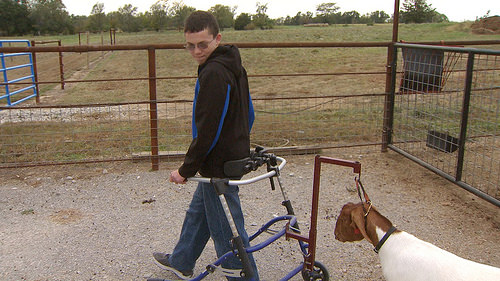
There’s a whole new generation of “soil mates” working to unlock the secrets in the soil.
The hope in healthy soil is taking root across America.
Farmers, ranchers, researchers, conservationists, non-profit organizations, foodies and others are all working to help regenerate our working lands by improving the health of function of our nation’s soil. So inspired by what they’re learning about the hope in healthy soil, there’s a whole new generation of “soil mates” working to unlock the secrets in the soil. Read more »

U.S. Department of Agriculture (USDA) Agricultural Research Service (ARS) entomologist Jay Evans and postdoctoral research associate Ryan Schwarz use a microscope to look at spores of the honey bee fungal parasite Nosema ceranae, which can replicate in cells lining the honey bee gut on Oct. 25, 2011. Photo by Stephen Ausmus.
“Top grade,” “strong,” “substantially strengthened,” and “significantly improved,” may sound like reviews you might read about consumer products such as smart phones or televisions. However, these are the actual terms used by the Union of Concerned Scientists (UCS) in its recent review of USDA’s updated Scientific Integrity Policy.
In a January 2017 report titled “Preserving Scientific Integrity in Federal Policymaking,” the UCS – a noted organization that represents the interests of the scientific community – gave USDA’s updated Scientific Integrity Policy (or SIP, for short) the highest rating assigned in a three-tiered rating system. Additionally, based on USDA’s release of a new procedural manual to accompany the SIP, USDA was one of only five federal departments or agencies (out of 18 reviewed) to receive a “strong” rating for its procedures for responding to scientific integrity concerns. Read more »

Missouri 4-H’er Riley Tade works with one of the goats in his 4-H project. Riley, who has cerebral palsy, is one of many youth in Missouri who don’t let special needs get in the way their love of agriculture and 4-H. (Image courtesy of University of Missouri Extension)
4-H is about more than barnyard animals, it’s about emerging sciences, like rocketry and geographic information systems. 4-H is also about leadership, citizenship, and many other things, but one quality truly stands out: 4-H is about inclusion.
In Missouri, 4-H clubs take an inclusive approach to working with youth who have special needs. “We don’t have set-aside or separate programs or activities for youth with special needs,” said Alison Copeland, campus 4-H specialist with University of Missouri Extension. “Rather, we provide our staff and volunteers with the tools and resources, such as sensitivity activities, to help staff increase their ability to work with youth of varying abilities in the same club or program.” Read more »

Follow these food safety steps to ensure no one will experience a food safety malfunction during your Super Bowl party.
It’s coming. The most popular TV event of the year — Super Bowl Sunday!!! That means the four F’s…Fun, Family, Friends and Food. The pressure is on. You don’t want to be the Super Bowl party host that your guests call — or even worse, post to social media — saying they got foodborne illness. If that happens…Houston, we have a problem!
Some estimates put the number of hours Americans will spend preparing food for Super Bowl parties near 10 million. From the TV setup to the delicious menu, it’s all about having fun, eating and watching the game (and the half time show of course). Start planning your viewing party with our four food safety steps: Clean, Separate, Cook and Chill. Read more »

NRCS staff, Environmental and Natural Resources Department staff with Tribal Council members Javier Loera and Michael Silvas.
This year, the Natural Resources Conservation Service (NRCS) will continue its resolution to build on its partnerships with Indian Country by supporting sustainably-managed crops and innovative ways to produce crops that are compatible with tribal cultures.
An example of these efforts is the relationship between the Ysleta del Sur Pueblo Tribe, located near El Paso, Texas, and NRCS. Working with NRCS, the Tribe constructed a seasonal high tunnel system at the Pueblo Education Center during a two-day workshop. The system provides an opportunity for Native youth to grow crops and take home fresh produce for healthy meals. Read more »

Within the lesser prairie-chicken’s range, predatory birds are more abundant in prairie grasslands with mesquite cover than in open grasslands. Photo courtesy of New Mexico State University.
For many, one of the New Year’s first big chores is to remove a tree from inside their home. Trees, beautiful and useful as they are, do not belong everywhere. Such is the case with trees and other woody species that are expanding into the Western grasslands.
Over the years, woody species like juniper, pinyon pine, redcedar and mesquite have encroached on grassland and sagebrush ecosystems, altering these landscapes and making them unsuitable for native wildlife like the lesser prairie-chicken and greater sage-grouse. Encroaching conifers also degrade rangelands for agricultural producers whose livestock rely on nutritious forage. Read more »
Tags: Bureau of Land Management, Conservation, Farmers, habitat restoration, land management, Lesser Prairie Chicken Initiative, New Mexico, New Mexico State University, NRCS, prairie chicken, Ranchers, Sage-grouse, Sage-Grouse Initiative, Wildlife, wildlife habitat
 Conservation
Conservation






